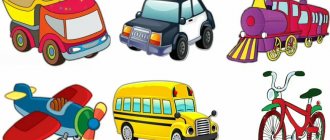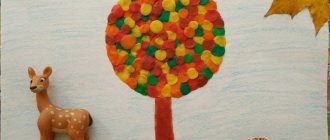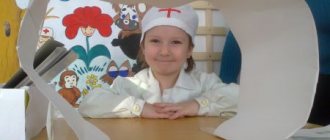What does it mean to talk to children about friendship and friends?
Of course, you can’t start a conversation about friendship in the younger group, where children from two and a half to three years old study. At this age, they will not fully understand the material presented. Although sometimes teachers are amazed at how little children understand what is bad and what is good.
And in the middle group, the age is appropriate, and the children are already accustomed to going to kindergarten, so for them others are not enemies, but allies. The purpose of a conversation with children is to teach them to clearly express their thoughts and outline the concept of morality. And friendship is an excellent topic for such a useful and educational pastime.
Conversations with children in the middle group can be both general and individual, depending on the needs of the child. Some children are still embarrassed to express their thoughts in front of everyone, especially if their family does not encourage them to do so.
Communication game “Friendship” (middle group)
Construct
organizing joint educational activities
according to PM.02 Organization of various types of activities and communication of children Ponomareva Tatyana
33 b groups
DOO:
Age group:
middle group (4 - 5 years)
Head of practice:
Temereva Lyudmila Petrovna
Methodist:
Ibragimova Daria Andreevna
Integration of educational areas:
Social and communicative development, speech development.
Kind of activity
: communication game
Subject:
"Friendship"
Form of organization:
group
Planned result:
Children show polite behavior towards their peers.
Children are able to regulate their actions in accordance with the rules of the game and form ideas about the rules of friendship.
Children have an idea of the concept of “friendship”.
Children have ideas about what qualities a friend should have
Children are able to analyze their feelings and the results of joint activities.
Children take part in group games.
Target:
nurturing a valued attitude towards friendship, friends, polite attitude towards peers, developing experience in participating in group games.
| Tasks | Tasks taking into account the age characteristics of children |
| Educational: cultivate a polite attitude towards peers, a value-based attitude towards friendship. Developmental: develop the ability to regulate your actions in accordance with the rules of the game, formulate the rules of friendship. develop the ability to analyze your thoughts and feelings, Educational: to form ideas about the concept of “friendship”, to develop the experience of participating in a collective game | Christina – develop perseverance |
Principles of education:
creating a positive emotional uplift, education through interaction, education through creativity.
Principles of training:
the principle of psychological comfort, the principle of activity.
Education methods:
methods of forming social experience (game); a method for children to comprehend their social experience (conversation); stimulation methods (creating a situation of success).
Teaching methods:
methods for developing cognitive interest (building a game plot, stimulating with entertaining content), methods for developing mental functions (creative task “building a ship”, creating a creative field).
List of sources used:
Federal state educational standard for preschool education. / Ministry of Education and Science of the Russian Federation, order dated October 17, 2013 N 1155.
Program "From birth to school". Basic general education program of preschool education / ed. N.E. Veraksy, T.S. Komarova, M. A. Vasilyeva. – M: Mosaic – synthesis, 2014; Federal State Educational Standard.
Progress of joint activities
| Stages of activity | Methods | Activities of a teacher | Children's activities | Planned result |
| 1. Organizational moment Task: attract children's attention. Motivate children for upcoming activities. | Emotional stimulation, demonstration. Conversation | The teacher motivates children to work together. - Guys, look, the postman brought an envelope, let's open it. Guys, this is a flash drive, do you want to know what's on it? The teacher takes out a flash drive from the envelope. Inserts it into the laptop and listens to the song “True Friend” (words by M. Plyatskovsky, music by B. Savelyev). — Guys, did you like the song? What is it about? That's right, about friendship. What is friendship? What are friends for? Who can you call a friend? Can an adult be your friend? (grandmother, father, mother, grandfather). Yes, because they love us, take care of us, read books to us. They teach us, buy us toys, candy... How do you think. Can a dog be your friend? Yes maybe. She protects us from evil people, plays with us. A friend can be any pet that lives in the house. - Guys, look who came to visit us today. Hello, monkey. What happened to you, why are you crying? Monkey: “What is it? Why am I always alone and alone? No one plays with me, no one says a kind word? I don’t know what friendship is and who friends are?” (crying) - Don't cry, monkey. Stay with us. The guys and I will teach you how to be friends and you will have many friends. Really, guys? — Guys, where does friendship begin? (With a smile) That's right, let's smile at each other. Guys, do you think that in order to meet people and make new friends, you need to know polite words? Do you know polite words? | They participate in dialogue, respond emotionally to the game situation, and make decisions. | |
| Children's attention is concentrated, children are motivated for the upcoming activity. | ||||
| 2. Main stage 2.1. Exercise “ Say the Word ” cultivate a polite attitude towards peers, a valued attitude towards friendship | Building a game plot, conversation, creating a situation of success, stimulation with entertaining content, game | - Guys, let's play a game, it's called “Say the Word.” Do you want to play? I will not read you a short poem to the end, but you will have to finish it. Do you agree? Then let's begin! 1. If you meet an acquaintance, either on the street or at home, Don’t be shy, don’t be disingenuous, but say louder... (hello) 2. If you ask for something, then first don’t forget to Open your lips and say... (please) 3. If You don’t want to be considered ignorant, I beg you, be wise, Begin your request with a polite word: Be kind and be….(kind) 4. If you meet a company, not hastily, not in advance, Then at the moment of parting, tell everyone….. (goodbye ) 5. If someone helped you in word or deed, Do not hesitate to speak loudly and boldly... (thank you) - Well done. So the first rule of friendship is: be polite and always smile. Our guys, the monkey, are very friendly, they try not to quarrel. | Take part in the game, show interest in peers, interact with each other | Children treat their peers politely. |
| 2.2. Game "Yes-yes-yes, no-no-no" develop the ability to regulate your actions in accordance with the rules of the game; formulate the rules of friendship; form ideas about the concept of “friendship” | Creating a situation of success, conversation, game, stimulation with entertaining content, game | - Well, to teach the monkey what real friends should be, let's play an interesting game. I will ask questions, and you will answer “yes, yes, yes” or “no, no, no.” Will we be strong friends? (yes-yes-yes) Treasure our friendship? (yes-yes-yes) Will we learn to play? (yes-yes-yes) Shall we help a friend? (yes-yes-yes) Do you need to piss off your friend? (no-no-no) And give a smile? (yes-yes-yes) Is it worth offending a friend? (no, no, no) Shall we drink tea with friends? (yes-yes-yes) Will we be strong friends? (Yes Yes Yes) Well done! We completed the task. Now the monkey knows what real friends should be like. | Listen to the rules of the game, actively participate in a group game, analyze the results of joint gaming activities, interact with each other | Children know how to regulate their actions in accordance with the rules of the game. Children know about the rules of friendship. Children have an idea of the concept of “friendship”. |
| 2.3. Game "Compliments" Task: to develop the experience of participating in a collective game | conversation, play, stimulation with entertaining content. | The teacher organizes the interaction of children, stimulates the activity of children, encourages them to participate in joint group games - Guys, do you know what compliments are? That's right, compliments are good and kind words. Monkey, do you know any compliments? Monkey: No, guys, I don’t know. Then let's teach the monkey to give compliments. Let's stand in a circle. You will take turns turning to your neighbor on the right, shaking your palms and saying, “Sasha, you are kind.” And so on. Example words: cheerful, beautiful, fast, bold, courageous, caring, polite, cultured, hardworking, friendly. A person's mood lifts from good words. -Guys, you know so many compliments. I'm very happy! Now the monkey knows what compliments are and how to use them. | Show active participation in the game, analyze the results of the collective game, interact with each other | Children take part in group games. |
| 3. Reflection Task: develop the ability to analyze your feelings, analyze the results of joint activities. | Conversation, stimulation with entertaining content. | The teacher stimulates reflection on the emotional states of children -Guys, we have completed all the tasks with you. Why do you think we were able to fulfill them? (because we were friendly) That's right, we were friendly. Monkey, did we help you? Monkey: Yes, now I know what true friendship is, thanks guys. Now you are my friends, will you take me to live with you in your kindergarten? | Analyze the results of activities, sum up the results of joint activities. | Children are able to analyze their feelings and the results of joint activities. |
| 4. Openness Task: Encourage children to engage in independent activities. | Emotional stimulation | - And now, after a lot of work done, I suggest you relax a little and go for a walk, walk with the monkey. | Express their thoughts and feelings | Children are focused on independent activity. |
What is the role of parents in raising a child?
It is important for parents to understand that only they are responsible for raising their child. Of course, children receive training in kindergarten, but this is nothing if parents do not impart moral values to their children at home. A teacher is not an enemy who turns a child against you, but an ally. He also cares about your baby's future.
Teachings such as talking with children about friendship and friends are beneficial and make things easier for mom and dad. Parents should take an interest in their child's life. To do this, you need to ask each time how the child spent his day. This way you will help your child not to be a closed person, but teach him to express his thoughts.
Remember, a child is a delicate plant that needs light and water. For children, they are love and attention, that essential vitamin that will help them grow up kind and smart. It is important for parents to nourish the soil so that subsequent information in the form of training is well received. If you treat your child with kindness and understanding, he will always be open to you like a reference book.
Is it easy to teach respect?
Finding a friend is not so difficult, but maintaining a good relationship is more difficult. It is worth teaching a child respect, that a good friend will never betray or hurt. In other words, he will not offend you either in word or deed.
It is important to emphasize that although there may be few friends, other children must also be treated with respect. If they see that someone has no one to play with, they need to come up and take him into the game.
Topics of conversations with children
There are more than enough topics for children's conversations, but this issue must be approached wisely. You shouldn't plan serious training every day. It is quite enough to have such a conversation once a week. And on other days, remind about the problem raised.
Talking to children about friendship and friends has a very positive impact on their lives. Already from kindergarten, a child learns warm relationships. And who knows, maybe this friendship will last a lifetime! The teacher plays a huge role in this.
How to explain to a child what friendship is?
Such a complex concept as friendship cannot be explained in a few words. It is necessary to make not only effort, but also to be patient. It has been scientifically proven that children perceive material better in the form of play. Why not ask the kids to sit in a circle and listen carefully to the teacher so as not to miss the rules of the new game?
A conversation with children about friendship and friends should begin with a question. For example, which one of you has a best friend? Everyone must be given the opportunity to respond. Although at first it will be difficult to maintain order, and the kids’ attention will constantly wander, but it’s worth a try. And if you promise a reward, the kids will stop misbehaving altogether.
Next, it would be good to clearly explain what it means to be friends. At the children's level, it will be something like “to be friends means not to offend, to share your toys and to help.” It is possible that this is also communication, do not forget to say hello and take an interest in your friend’s affairs, etc.
In turn, a friend is someone who is always there and will help in difficult times. For example, to get dressed or put on shoes, teach how to tie shoelaces and a scarf. The one who always shares lunch.
This, of course, is an art - to convey important thoughts to a child, but in simple language. But what won’t educators do for their students? After all, the goal of kindergarten is not just to entertain the child, but to teach.
Summary of a lesson by a teacher-psychologist with children of the middle group “Why do we need friends”
Aisylu Belogrud
Summary of a lesson by a teacher-psychologist with children of the middle group “Why do we need friends”
OA goals.
Educational:
Expand and generalize children’s knowledge about the concepts of “friend”, “friendship”; introduce children to the rules of friendly relations.
Educational:
promote the development of the ability to understand the emotional state of another person and adequately express your own; promote the development of communication skills and abilities.
Educational:
promote the formation of friendly relationships in the group, uniting the children's team.
Equipment: 5 balloons, markers, a ball, a toy bear, pictures of fairy-tale characters (positive and negative, small smiling emoticons cut out of yellow paper (according to the number of children), a sheet of cardboard on which a house is drawn (a house made of colored cardboard).
OD move.
1. Ritual of the beginning of the lesson. Greetings.
Children sit on chairs in a semicircle.
Psychologist: Hello, guys! In order to start our lesson, we need to sit comfortably on chairs and listen to the music (listening to the melody, and now, let's close our eyes and listen to our breathing.
Psychologist: And so, we are ready to start our lesson, now we will play the game “I Like You.” The ball I hold in my hand will help us express the warm feelings we have towards our friends. So, now we will pass the ball to each other, and talk about why the friend who sits next to us can become our best friend. The game continues until each of us hears warm words addressed to us.
2. Conversation about friendship
Psychologist: Well done guys, you coped with the task ahead of us. Today Mishka came to visit us. He told us in confidence that he had no friends at all. And he asks us to teach him to be friends. Shall we help Mishka? Yes? Then, let's tell Mishka:
• What is friendship?
• Why do we need friends?
Psychologist: Friendship is when people want to be together, when they play together, communicate, and don’t quarrel. Friendship is the smiles of friends. Friends are people with whom we are interested in playing. Friendship is when you know how to come to an agreement without shouting and quarreling; share toys, speak politely and not be rude; be attentive (caring) to a friend; be able to sympathize with a friend. If a friend is happy, then rejoice with him; if there is trouble, then be sad together. Raise your hands if you have friends. (Children raise their hands).
3. Conversation-game “Mood”.
Psychologist: Guys, now I would like to know what your mood is today. Why are you happy or happy?
Guys, look, there are balls on the table here. Let's imagine that these balls are the faces of children we know. You and I need to make these faces happy. To do this, we will take felt-tip pens and draw happy faces with them. But before that, we need to split into pairs. I have ribbons in my hands, come up and grab any ribbon. Those who have the ends of the same ribbon in their hands will stand in pairs. Well done! Now take one ball for each pair and get to work!
4. Game “Good - bad”.
Psychologist: In order to teach Mishka to be friends, we will play with you the game “Good - Bad”. Let's listen to the rules of the game. I will talk about people's actions. If the deed is good, clap your hands; if it is bad, remain silent. (The psychologist names actions: “quarrel, help others, fight, make peace, greet each other, brag, ask for forgiveness, be greedy, share, call names, say nice words, be polite, be rude, give in”).
Psychologist: Now let's tell Mishka what needs to be done so that they want to be friends with us. How to be friends properly? (children's answers). So, what should you do to avoid quarreling? (Give in, share).
Let's show Mishka how to be friends and help friends.
5. Dynamic pause “If there is a good friend”
The mood has dropped, the matter is falling out of hand. children stand facing each other, hands up, gradually lower their hands
But all is not lost yet, they shake their fingers at each other
If you have a good friend. clap their hands
Let's handle this together, hold hands
Let's breathe a sigh of relief, sigh
Raise your spirits raise your hands up
And shake off the dust. shake off the dust. Smiling at each other
6. Game “Make friends with a fairy-tale hero”
Psychologist: Guys, Mishka and I will take turns showing you pictures of characters from different fairy tales and cartoons. All of them have different characters and actions. If you would like to be friends with the hero I will show, raise your hand; if you would not like to, do not raise it. The psychologist shows pictures with characters one at a time (Cinderella, Thumbelina, Pinocchio, Baba Yaga, Leopold the cat, Koschey the Immortal, Gorynych the serpent, Luntik). After showing each picture, the psychologist asks the children why they would/would not want to be friends with the fairy-tale hero.
Psychologist: Guys, why didn’t you choose these heroes? (shows pictures of negative characters that the children did not choose) (children’s answers). Nobody wanted to be friends with evil, greedy, unfriendly fairy tale characters. In order for people to want to be friends with us, we need to have good qualities. Be kind, cheerful, honest, ready to help. But you can also make friends with negative characters, but you need to teach them to be kind, not to do bad things, and teach them the rules of friendship.
Psychologist: Well done guys, I learned that you are all kind, polite, beautiful, cheerful. This means that you know how to be friends, and there is a smile in your group.
7. Friends for Mishka
Psychologist: Now Mishka knows what friendship is and why friends are needed. But he has no one to play with or be friends with. Let's help our Bear and make him friends out of sand. But, since we are friendly, polite guys, we will do this in pairs! So let's gather in a circle, and each of you will pull out one image from the magic bag and find a pair (pairs: circle and triangle, hedgehog and fox, apple and pear, cat and dog, cucumber and tomato - according to characteristics) (children perform task - in pairs, bear cubs are sculpted in one tray with sand).
Psychologist: Look how great you did! The bear will play with new friends and make friends. And now, it's time for us to say goodbye. Thank you very much, guys, for helping Mishka learn what friendship is and teaching him to be friends. Did you like our lesson today? What did you like most? Goodbye, guys!





